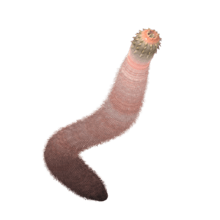Ancalagon (animal)
Ancalagon minor is an extinct priapulid worm known from the Cambrian Burgess Shale.[3]
| Ancalagon | |
|---|---|
 | |
| Reconstruction of Ancalagon minor | |
| Scientific classification | |
| Kingdom: | Animalia |
| Stem group: | Priapulida (?) |
| Class: | †Archaeopriapulida |
| Family: | †Ancalagonidae Conway Morris, 1977[1] |
| Genus: | †Ancalagon Conway Morris, 1977[1] |
| Species | |
| |
| Synonyms | |
| |
Because it superficially resembles the modern-day internal parasites known as the acanthocephalids or "spiny-headed worms," A. minor was once thought to be, or once thought to resemble the hypothetical free-living ancestor of acanthocephalids.[3][4] Two specimens of Ancalagon (animal) are known from the Greater Phyllopod bed, where they comprise < 0.01% of the community.[5]
Along with the other Cambrian worms such as Ottoia, Selkirkia, Louisella, Fieldia, Scolecofurca, and Lecythioscopa, the organism may fall into a clade termed "Archaeopriapulida," a stem group to the Priapulids proper.[6] However, the morphological similarity of these organisms to their modern cousins is remarkable, especially for the Burgess Shale.[7] A phylogenetic analysis does not provide a great deal of resolution to the relationships between these basal worms.[8]
The generic name is a homage to the dragon Ancalagon of J.R.R. Tolkien's Middle-earth legendarium, in reference to the worm's prominent rows of hooks on its proboscis.[9] The species was previously placed in the genus Ottoia, as Ottoia minor, but was removed by Simon Conway Morris, who noted morphological differences.[10]
Morphology
Ancalagon had a slender, cyndrical, radially symmetric body[10] averaging 6 centimeters in length. Its proboscis was armed with circum-oral hooks at the anterior. There were about 10 of these hooks, equal in size and with prominent bases. Directly posterior was an unarmed space, followed by posteriorly directed spinose hooks. The trunk is annulated with 0.2 to 0.25 millimeter spacing, and carried rows of setae possibly performing sensory functions. The apparent absence of retractor muscles correlates with Ancalagon's inability to significantly invert its proboscis. The organism was probably a burrowing predator.[1]
See also
Ankalagon, a mesonychid ungulate also named after Ancalagon the Black.
References
- Conway Morris, S (1977). "Fossil priapulid worms". Special Papers in Palaeontology. 20.
- Haaramo, Mikko (2003). "Scalidophora – †palaeoscolecids, priapulids, mud dragons and brush heads". Mikko's Phylogeny Archive. Retrieved May 14, 2019.
- Conway Morris, S. (1979). "The Burgess Shale (Middle Cambrian) Fauna". Annual Review of Ecology and Systematics. 10: 327–349. doi:10.1146/annurev.es.10.110179.001551.
- Morris, S. C.; Crompton, D. W. T. (1982). "The Origins and Evolution of the Acanthocephala". Biological Reviews. 57: 85–115. doi:10.1111/j.1469-185X.1982.tb00365.x.
- Caron, Jean-Bernard; Jackson, Donald A. (October 2006). "Taphonomy of the Greater Phyllopod Bed community, Burgess Shale". PALAIOS. 21 (5): 451–65. doi:10.2110/palo.2003.P05-070R. JSTOR 20173022.
- Por, F. D. (1983). "Class Seticoronaria and Phylogeny of the Phylum Priapulida". Zoologica Scripta. 12 (4): 267–272. doi:10.1111/j.1463-6409.1983.tb00510.x.
- Huang, D. Y.; Vannier, J.; Chen, J.Y. (2004). "Anatomy and lifestyles of Early Cambrian priapulid worms exemplified by Corynetis and Anningvermis from the Maotianshan Shale (SW China)". Lethaia. 37: 21–33. doi:10.1080/00241160410005088.
- Wills, M. A. (1 April 1998). "Cambrian and Recent Disparity: the Picture from Priapulids". Paleobiology. 24 (2): 155–286. JSTOR 2401237.
- "Ancalagon minor". The Burgess Shale. Retrieved 19 September 2012.
- Whittington, H.B. (1911). "Middle Cambrian Annelids". Cambrian Geology and Paleontology. 2: 109–142.
External links
- "Ancalagon minor". Burgess Shale Fossil Gallery. Virtual Museum of Canada. 2011. (Burgess Shale species 96)